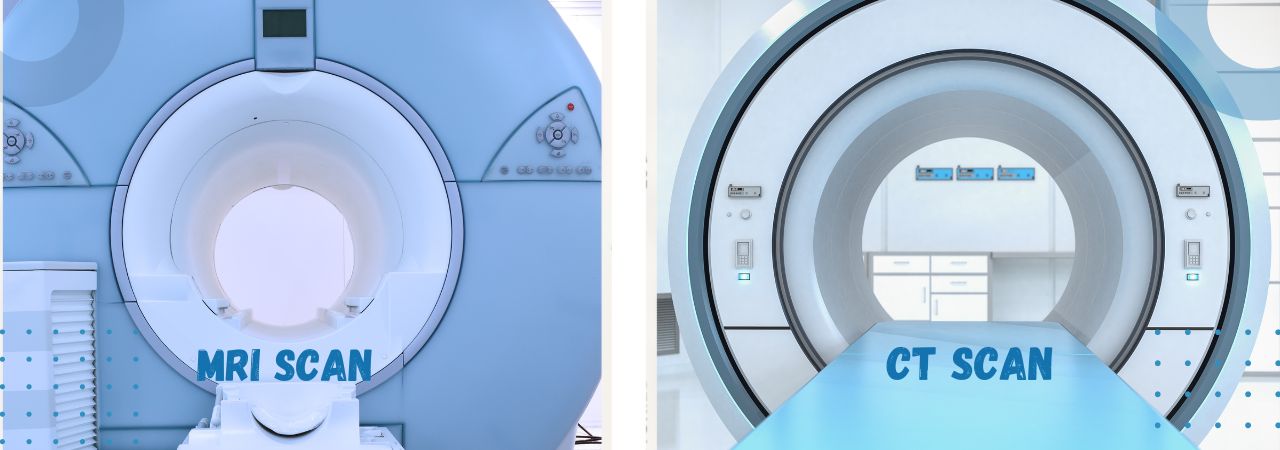CT Scans vs MRI
In the realm of medical imaging, two prominent techniques are recognized for their capacity to deliver intricate images of the body’s interior: CT (Computed Tomography) scans and MRI (Magnetic Resonance Imaging). Both serve as essential diagnostic instruments, yet they are utilized for distinct purposes based on the clinical context. A clear understanding of the differences between these two modalities can assist healthcare professionals in selecting the most appropriate imaging method for each patient, thereby facilitating accurate diagnoses and effective treatment plans.
When should physicians choose a CT scan over an MRI, and vice versa? Let us explore the distinctions and common applications of each imaging modality.
What is a CT Scan?
A CT scan employs X-rays in conjunction with sophisticated computer algorithms to generate detailed cross-sectional images of the body. Unlike conventional X-rays, which yield only flat, two-dimensional representations, a CT scan captures multiple X-ray images from various angles and integrates them to form a three-dimensional image. This technique provides a more comprehensive view of the internal structures of the body.
CT scans are frequently utilized for:
– Assessing bone fractures
– Evaluating head injuries
– Detecting and staging cancers, including metastases
– Identifying internal bleeding
– Investigating abdominal and chest conditions, such as lung diseases or cardiac issues
What is an MRI?
An MRI utilizes strong magnetic fields and radiofrequency waves to create detailed images of organs, soft tissues, and internal structures. Unlike CT scans, MRI does not involve exposure to ionizing radiation. The magnetic field aligns hydrogen atoms within the body, and radio waves disturb this alignment. The MRI apparatus then captures the signals emitted as the hydrogen atoms revert to their original state, resulting in highly detailed images, particularly of soft tissues.
MRI is typically employed for:
– Imaging the brain and spinal cord (e.g., for brain tumors, multiple sclerosis, spinal cord injuries)
– Diagnosing joint and muscle conditions (e.g., tears, arthritis)
– Evaluating heart disease (e.g., examining the heart’s chambers and blood flow)
– Conducting abdominal imaging, especially of soft tissues like the liver and pancreas
Key Differences Between CT Scans and MRI
CT Scans: These scans primarily generate detailed images of bones and hard tissues, making them particularly effective for identifying fractures, internal bleeding, and cancers in solid organs. They are often the preferred option when rapid and comprehensive body imaging is required.
MRI: This imaging technique offers superior resolution for soft tissues, including muscles, tendons, and organs such as the brain, heart, and liver. It is more adept than CT scans at identifying conditions affecting soft tissues, including ligament injuries, neurological issues, and tumors in soft tissue.
2. Radiation Exposure
CT Scans: These scans utilize ionizing radiation (X-rays), which limits their frequency of use, particularly among younger patients and pregnant women, due to potential risks associated with radiation exposure and its long-term consequences, such as an elevated risk of cancer.
MRI: This method does not involve radiation, making it a safer option, especially for repeated imaging or for vulnerable populations like pregnant women (in most cases). However, individuals with certain implants, such as pacemakers or cochlear devices, may be unable to undergo an MRI due to the strong magnetic fields involved.
3. Speed of the Procedure
CT Scans: These scans are significantly quicker than MRIs, often completed within just a few minutes. This rapidity makes CT scans the preferred choice in emergency situations where time is of the essence, such as in cases of trauma or stroke.
MRI: The scanning process typically lasts between 20 to 45 minutes. The duration may extend if multiple body areas require imaging or if the patient must remain still for longer periods. Due to this extended time frame, MRI is generally less suitable for urgent diagnostic needs where prompt results are essential.
4. Cost and Availability
CT Scans: Generally, these scans are more affordable than MRIs and are more widely accessible. Most hospitals and urgent care facilities are equipped with CT scanners, facilitating easier access for patients in various healthcare settings.
MRI: This imaging option tends to be more costly, and MRI machines are often less prevalent in smaller healthcare facilities. Consequently, patients may experience longer wait times for MRI appointments.
